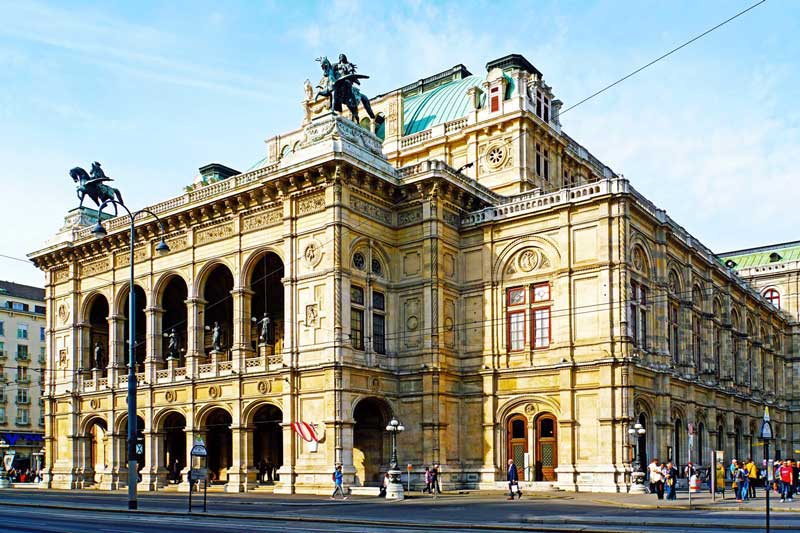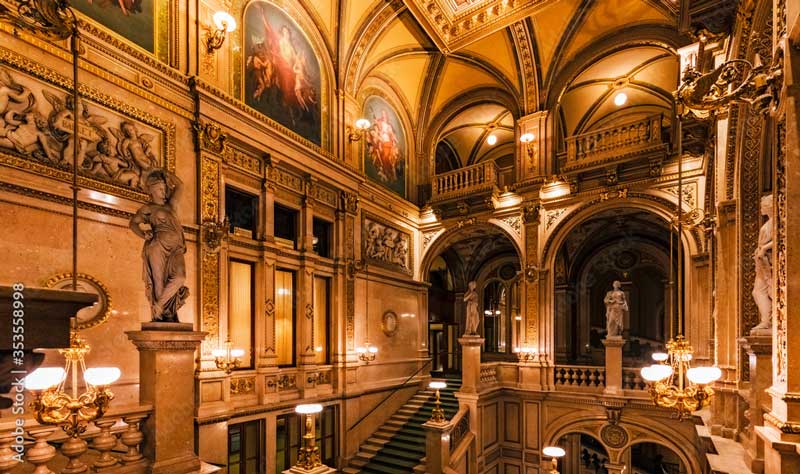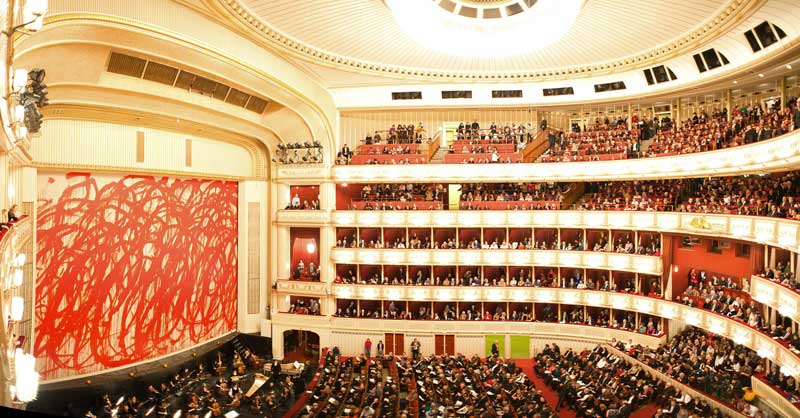
The Vienna State Opera, locally known as Wiener Staatsoper, was the first opera built in Vienna and the first major building on the Ringstrasse, commissioned by the controversial Viennese city expansion fund. Work on the building commenced in 1861, following plans drawn up by the Austrian architects August Sicard von Sicardsburg and Eduard van der Nüll and designed by Czech architect Josef Hlávka and was solemnly opened on 25 May 1869 as the Vienna Court Opera with Mozart’s Don Giovanne, in the presence of Emperor Franz Joseph I and Empress Elisabeth of Austria.
Unfortunately, none of the architects lived to see the opening of the opera house, as Eduard van der Nüll committed suicide, probably due to depression for some unknown reasons and his friend August Sicard von Sicardsburg died of a cerebral haemorrhage. Nevertheless, the opera house earned its current name in 1921, after the establishment of the First Austrian Republic.

However, the building of the opera house, built in Neo-Renaissance style by the renowned Czech architect and contractor Josef Hlávka, failed to make any positive impression and was not very popular among the mass, as it did not even seem as grand as the Heinrichshof, a private residence which was later destroyed in World War II Moreover, since the level of Ringstrasse was raised by a metre in front of the opera house after its construction had begun, the building seemed to be a sunken treasure chest and was contemptuously termed as the Königgrätz of architecture, referring to the disastrous Battle of Königgrätz of 1866, in which the Austrian Empire was decisively defeated by the Kingdom of Prussia.
On the other hand, the builders also had to face difficulty as they wanted somewhat coarser-grained Kelheimer stone as the main stone for the building of the opera house, which was not available in sufficient quantity. Ultimately, they were suggested to use Breitenbrunn stone as a substitute for the Kelheimer stone, even Jois stone was also used as a cheaper alternative to the Kaiserstein. While polished Kaiserstein stone was used for the construction of the staircases, most of the rest of the interior was decorated with assorted varieties of marble.

The Wiener Staatsoper opera house is flanked by two fountains by Josef Gasser, signifying two sides of the world: music, dance, joy and levity on the left and seduction, sorrow, love and revenge on the right. While the facades of the building are decorated with Renaissance-style arches, its balconies on the Ringstrasse side reflect the public character of the building. The statues of two equestrians, created by Ernst Julius Hähnel and representing Erato’s two winged horses, led by Harmony and the Muse of Poetry, were placed on the main facade of the loggia in 1876.
There are five more bronze statues, created by the same artist, representing heroism, tragedy, fantasy, comedy and love, placed on the top of the arches above the balconies.

The rear part of the opera house, containing the stage and the surrounding rooms, is broader than the front part, which includes the auditorium and the adjoining rooms that are open to the public. But strangely, different parts of the building have remarkably different types of roof styles. While the stage and auditorium that towers above all the secondary rooms have the vaulted roof, the transverse wings, enfaced with the coats of arms of the Austro-Hungarian Empire at the front, have the hipped roof. The connecting structures between the transverse wings, which stand perpendicular to the main building and originally served as driveways for horse-drawn carriages, have the gable roof, but the towers have French roofs.

The interior of the Wiener Staatsoper opera house, comprising the whole main front, the main lobby, the central staircase, the Schwind Foyer and the attached balcony and the Tea Salon on the first floor, have been preserved in their original state. The ceiling of the staircase is adorned with a painting, depicting fortune scattering her gift, inspired from a design by Franz Dobiaschofsky, whose works also included the canvas paintings in the three arches, illustrating the ballet, comic opera and tragic opera. The allegorical statues, representing the seven liberal arts, namely architecture, sculpture, poetry, dance, musical art, drama and painting, were designed by Josef Gasser. The former Imperial box, with its ceiling and walls lavishly decorated with 22 carat gold leaf, previously reserved for Vienna’s royalty and their guests, has a beautifully painted ceiling by Karl Madjera, depicting the Music on Eagles’ Wings, signifying both lyrical and tragic music. While the Tea Salon, formerly the Emperor’s Salon, is located between the staircase and the central boxes, the Tapestry Hall, named because of the tapestries adorning its walls, is located to the right of the stairs, which was renamed Gustav Mahler Hall on 11 May 1887, to celebrate the 100th anniversary of Gustav Mahler, for his conducting debut at the opera house.

World War II marked a black chapter in the history of the Wiener Staatsoper, during which many members of the house were driven out, captured, tortured and killed by the Nazis and performances were strictly restricted. Ultimately, on 12 March 1945, towards the last phase of the Great War, the opera was severely damaged by an American bombardment, when the ensuing blaze devoured the auditorium and the stage, as well as almost the entire décor and props for more than 120 operas with around 150,000 costumes. Fortunately, the front section, which had been walled off as a precaution, remained intact, including the foyer, with frescoes by Moritz von Schwind, the main stairways, the vestibule and the tea room.

Nevertheless, after the end of the war, the State Opera was temporarily housed in the Theatre an der Wien, a historic theatre, located on the Left Wienzeile, a street in Vienna and at Vienna Voiksoper. Followed by lengthy discussions about whether it should be completely demolished and rebuilt, either on the same location or a different site, the decision was made to rebuild the opera house as it had been. Accordingly, an architectural competition was announced, which was won by Erich Boltenstern, who decided on a design similar to the original with some modernisation in keeping with the design of the 1950s. While wood was the favoured building material to achieve a good acoustic, the number of seats in the stalls was reduced and the fourth gallery, which had been fitted with columns, was restructured to avoid columns. The facade, entrance hall and the foyer were restored in their original style, but the original seating capacity of the auditorium was reduced from 2881 to 2282, of which 1709 are sitting, 567 are standing, four are wheelchairs and four are accompanying place. For safety measures, the large centre chandelier was replaced by a lighting wreath made from crystal.

Finally, the Wiener Staatsoper was reopened on 5 November 1955, in the presence of the American Foreign Minister, John Foster Dulles, with a new auditorium, equipped with modern technology. Later, the building underwent a renovation and a refurbishment process in 1991 and 1993, when several rehearsal rooms were arranged, which include 10 soloist rehearsal rooms and two ballet rehearsal spaces.